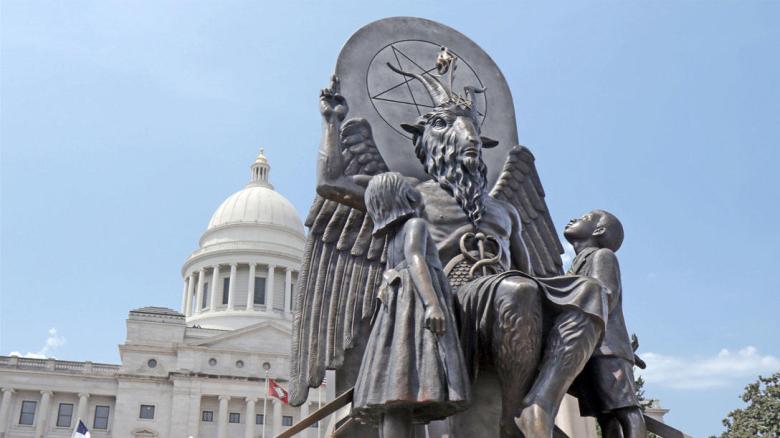Review: Hail Satan? (2019) by Penny Lane

That there is no one who’s actually practicing virgin-sacrificing on graveyards under the light of candles arranged to form a pentagram, doesn’t really matter. Such picture is present in the minds of state-, church- and media gurus who imprint it to hearts and minds of submissive, god-fearing citizens. Truth to be told, some individuals from the Satanic circles also contributed to it for various reasons, be it through the hollow provocations of Anton LaVey, the leader of the Church of Satan from the 60’s, or ideologically dubious actions like those undertaken by some individuals of the Norwegian black metal scene from the 90’s.
The American non-theistic religious and political organization The Satanic Temple, which is the subject of Penny Lane’s documentary Hail Satan? (2019), opts for other paths. It all starts with the way they see Satan, which is quite different from the other organizations with similar names and iconography. They see Lucifer as the first rebel against the tyranny and the free-spirited and free-thinking critic of an absolutist, dogmatic authority. For them, he is more of a knowledge idol than an evil deity, so the motivations for their actions is different – instead of pose and destruction, they opt for social activism.
The Satanic Temple uses the shock tactic of their predecessors, but for them, it is just tactic. In the weird world of today, the forces of evil from the ancient books are the ones on the first lines of defense of the humanistic and democratic values, opposing the fundamentalist axis of those who declare themselves to be the good guys.
The question is, however, should the Satanists be chose to lead that fight and the answer seems to be positive. Atheism, no matter how radical, is boring in the sense of iconography, which could be a crucial aspect in the spectacle society of today. So that is the reason for unnaturally coloured contact lenses, tattoos, rituals arranged like art performances and the rest of “darkness”. It is just something that is placed in the proverbial show-window to attract the rebels, rejects and renegades, as well as the “decent” people who can function perfectly in the world they despise. Beside the carefully designed actions of social and political activism, the iconography hugely contributed to the surge in the number of members of The Satanic Temple from 3 to over 50 thousand in the span of just a few years. The American “franchise” is by now exported to other countries like Sweden, Australia and South African Republic.
Hail Satan? (2019) tackles the topic of The Satanic Temple as a phenomenon. It is not the bravest and stylistically most provoking Lane’s work, having in mind her constant use of “talking heads” interviews combined with some of the archival footage. Some kind of hesitation could also be read from the very title of the film because of the unnecessary question mark. Lane’s findings are not exactly new either, like the common knowledge that America decided to present itself as a Christian nation only during the Cold War so it could distinct itself from the dogmatically atheistic Soviet Union.
But the dramaturgical foundation of the film is quite solid and it works all the way through. Lane opts to present the protagonists and does not shy away from the rifts in their internal dynamics, as well as the wide array of antagonists from the ranks of corrupt churches and the evangelical political right. In the end, it is well packaged, TV-friendly, smooth and fun to watch.
The difference between Hail Satan? and similar documentaries lays in the sheer attractiveness of TST’s actions. Some of them are quite local in scope, like beach- and motorway cleaning (done with tridents, because why not). The others are aimed to educate the common folk, like the Satanic School debate clubs, or are simply humanitarian by nature, like collecting the clothes for the homeless people or giving away the hygienic products to the women. Some of them are the clear examples of political action to secure the fundamental right of choice or to improve gay rights. All of them show the significant tendencies to attention-grabbing through the parody of the official religious dogmas. The others are taken beyond the closed courtroom doors, like the fight to raise the monument to Baphomet on the State ground (with an argumentation that, if there could be a Christian monument on the public ground in a nominally secular state, there could be a Satanic one too) or to open the possibility of the Satanic prayer at school alongside the Christian one.
Penny Lane is otherwise known for picking unusual perspectives aimed at scrutinizing the American society and its history. Our Nixon was an outstanding collage of amateur “home movies” filmed by the associates of the corrupt American president that presented his reign from an insiders’ perspective. Nutts was a “stranger than fiction” story about the eccentric “genius”, or a common schemer, who treated the impotence with a “medicine” based on goat’s testicles. With her previous film The Pain of Others, she used the found footage technique to examine the mysterious and often negated decease caused by hypodermal parasites. Hail Satan? might be the most conventional documentary made by Lane, but, with a focus to the protagonists and their hugely important mission, it is well worth the viewer’s time.
*the review is translated and adapted from an article written for Dokumentarni.net (and published on July 31st, 2019) by the same author, re-published with the permit of the editor Hrvoje Krstičević.
















